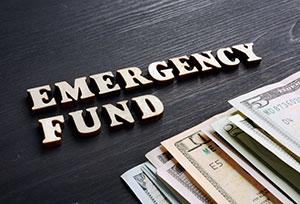Set Up An Emergency Fund
Set Up An Emergency Fund
You’re probably familiar with the idea of an emergency fund. Everyone should have a little bit of money set aside “just in case.” Here’s how you can get started, even if saving seems difficult.
What an Emergency Fund Is Not
Having an emergency fund doesn’t mean you mentally allocate some of your retirement investments as “for emergencies.” An emergency fund needs to be liquid, meaning you can access it quickly when you need it. Additionally, it shouldn’t have any exposure to negative value fluctuations. Suppose your “emergency fund” is invested and something goes seriously wrong in your life just as the markets tank. You’ll be doubly dazed as you realize serious capital losses.
Why You Need an Emergency Fund
It can be difficult for anyone who hasn’t “been there” to understand how quickly something unfortunate can seem to turn life upside down. Are you such a person? Does an emergency fund seem unnecessary? Right now, imagine that you arrive home tonight and notice a pipe has burst! Water is flooding your home and you need to get a plumber to repair it. If you don’t have cash on hand, what would you do?
How Much Do You Need?
The term “emergency fund” means different things for everybody. In general, the ideal emergency fund doesn’t need to be much more than three to six months’ worth of living expenses. However, most people have a difficult enough time putting enough away for retirement. If that sounds like you, then three to six months of living expenses may seem like a laughable tall order. Instead of stressing yourself out and trying to build that amount up all at once, do it in tiers.
Tier 1: Dealing with Small Emergencies
• A “tier 1” emergency fund is between $500 and $1,500. A fund of this size is a great buffer against small, yet common, emergencies. For example, if your vehicle breaks down or your pet needs to see a veterinarian, you’ll be able to handle it. If you’re a student or you’ve recently graduated, this is what you should aim for. Set aside $10 to $30 every week and you can build this up in a year.
Tier 2: Support for Moderate Emergencies
• Once you’re in the workforce and have a reasonable income going, it’s a good idea to start working on “tier 2.” Set aside money until your fund is around $2,000 to $6,000. This ought to be enough to help diffuse moderate health care costs or a few months’ rent if you find yourself in a tight spot.
Tier 3: A Few Months of Breathing Easy
• Finally, once your career is moving along at a steady clip and you’re collecting a comfortable income, it’s time to work on building up your emergency fund into an amount that would allow you to continue a lean version of your lifestyle for three to six months. This will help cover you in case something major happens, like the unexpected loss of a job, or major damage to your home that insurance doesn’t cover.
Putting away money for an emergency fund might not seem exciting, but you’ll be awfully glad you did in the long run. Even though the money isn’t generating interest, it will be generating a different kind of value for you: peace of mind.
« Return to "CFFCU Blog"

